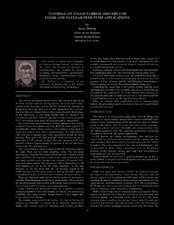| dc.description.abstract | This tutorial will present an overview of the operation and design of steam turbines used for driving reactor and boiler feed pumps, called a boiler feed pump turbine (BFPT). Overall, these turbines are designed in much the same way as other mechanical drive turbines; however, there are characteristics to these units that make them unique to this application. A feed pump turbine must be integrated and completely compatible with the pump and the main turbine generator (TG) unit because these pieces of equipment are so interrelated. One of the most unique features of these turbines is their ability to operate from two separate and very different steam supplies. To accommodate these steam sources, two separate inlets must be used, each with its own special characteristics. The high pressure (HP) inlet has a separate steam chest designed to accept the boiler pressure. This inlet will feed a nozzle block that has an arc of admission of 25 percent or less. The low pressure (LP) inlet generally utilizes approximately 50 percent of the arc and has a much larger flow passing area. This type of turbine varies in output across the operating range of the plant. There are two basic operating cycles. The two pump operating cycle usually runs between 40 percent and 110 percent main unit load (MUL), this operation is achieved by using all LP steam. The one pump operating cycle, startup to approximately 65 percent MUL, uses both steam sources. The percent of each is determined by the load required, as well as the LP steam conditions. As the load increases on the TG main unit, the LP pressure supply to the BFPT increases, the HP steam is used to start up the BFPT unit and supplemented by the LP steam source to achieve the required load. There are numerous other factors beside modes of operation to consider when designing a boiler feed pump turbine. These include the speed and power requirements of the pump, steam characteristics from the main unit and boiler, and exhaust pressure. From a mechanical perspective there are a number of design features available on the style turbine to consider for maintaining reliability. The most obvious design feature is the single flow versus double flow design. The rotating component of the turbine, the rotor, is the key for maintaining reliability. It consists of an integrally forged shaft, blades with various styles of fastening, and shrouds or blade covers. The blades have either an axial or radial entry design root to secure them to the disk portion of the shaft. Shrouding also has multiple variations. It can be riveted, integral, integral with wire, or an integral interlocking design. Stationary elements consist of the diaphragms and labyrinth seals. The diaphragms direct the flow between the rotating blade rows. All boiler feed pump turbines have two journal bearings and a thrust bearing. In most cases tilting pad journal bearings are used because of their inherent stability and damping characteristics. Thrust bearings are mostly the standard double acting type. Controlling the steam flow to the turbine is done with the valve operating gear assembly. This assembly consists of simple linkage arrangement that controls the lift of the diffuser valves feeding the low pressure chest and the high pressure valve. The entire assembly is raised and lowered by an oil controlled servo motor. There are various other peripherals such as turning gears, probes, and rounding brushes that may or may not be used, which will also be discussed. | en |


